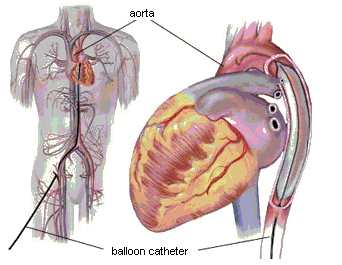Mathematical model of intraaortic balloon pump (IABP)
Intraaortic balloon pump (IABP) is a method of the accessory blood circulation, its purpose is a reduction of a heart load under the acute cardiac incompetence. The main point of this method is
bringing a
balloon
in the aorta, this balloon can dilate and contract under the action of an external controlled
pneumatic pump. The balloon contracts in a period of the ventricular systole and dilates in a period of the ventricular diastole, creating an additional peak on a curve of the aortic pressure and promoting an additional
blood expulsion
from the aorta. At the end of the diastole the balloon dilates, it leads to the aortic diastolic decompression, promoting a resistance reduction to the blood expulsion from the left ventricle under the following systole.
 Intraaortic baloon pump Intraaortic baloon pump |
|
|
In our model the balloon influence to the arterial systemic pressure is evaluated by a supplementation of an additional volume VBAL in the formula (23):
  |
(65) |
As a mathematical model of a balloon volumetric change we choose the following expression.
  |
(66) |
In the formula (66)
where Tsn - ventricular systolic duration in n-cardiac cycle , Tn - cardiac cycle duration .
 Intraaortic baloon pump Intraaortic baloon pump |
|
 |
A dependence of intraaortic balloon volume from a time on the cardiac cycle
|
|
|
A formalization of IABP purposes is necessary for a.choose of criteria of a method efficiency. In the work [3] an estimation of method efficiency is realized on the following key parameters.
A systolic index "pressure-time"
 |
(67) |
A diastolic index "pressure-time"
 |
(68) |
Criterion of heart energy supply
 |
(69) |
The index TTI allows to indirectly estimate power inputs of the myocardium during one cardiac cycle. According to [3] heart power inputs are proportional to TTI. With the help of DPTI we can make an indirect estimate of heart energy supply. So, the value E is the indirect measure of myocardial energy supply.
Mathematical model > Units of artificial and accessory blood circulation > Mathematical model of intraaortic balloon pump (IABP)
References on the topic:
|







